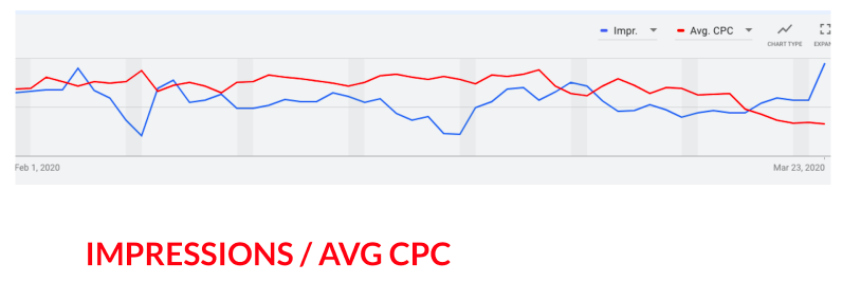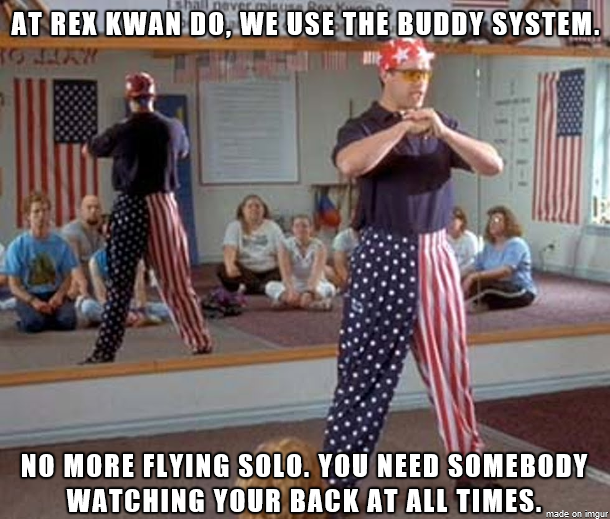Webinar: 12 Tips for Approaching Marketing During COVID-19 Uncertainty
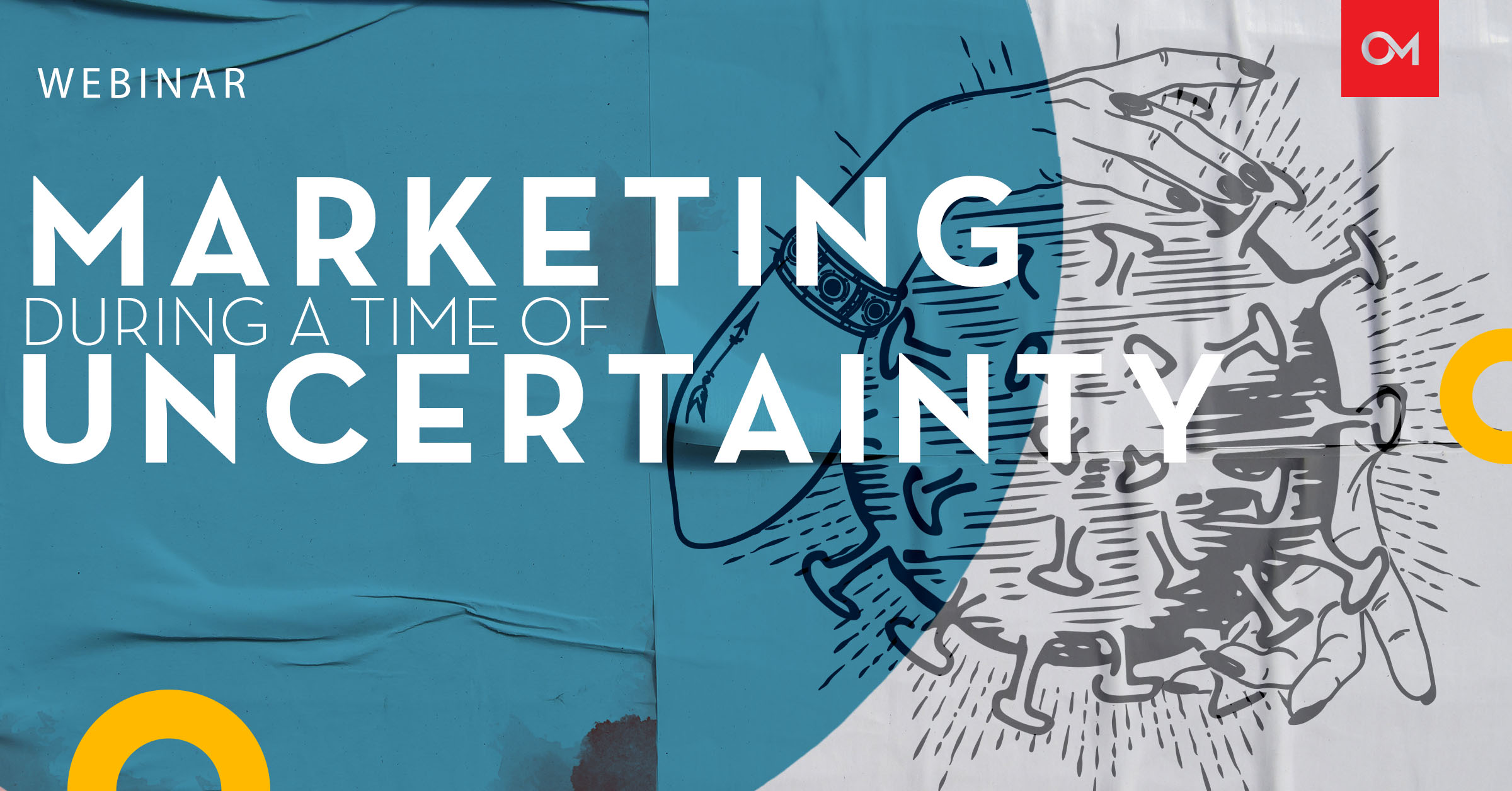
David Smith is the former COO of Oozle Media, and he has years of experience helping businesses with their marketing decisions. He had a big impact on Oozle Media and helped bring us to where we are today. As part of our webinar, we kept it brief, but we will be updating this blog as questions and recorded conversations happen about what businesses should be doing at this time.
Watch the Webinar
Read the Blog
Here is advice directly from Dave in his words:
While nobody’s business is untouched by the COVID-19 crisis, it’s an especially hard time to own and operate a small business that relies on human interaction. The measures being taken to protect people and prevent the spread of the disease have temporarily shut many businesses down or asked them to wildly adapt their business to continue operating. To make things more complicated, all signs seem to point to it getting worse before it gets better.
Marketing right now is particularly fraught with pitfalls. Something that was appropriate last week could easily be out of date today and a real PR risk next week.
Over the last decade, I’ve worked with hundreds of small businesses to help develop effective marketing strategies. It’s given me a unique perspective to get to know different types of business owners and see the results of their approaches to marketing under all kinds of circumstances.
I’m hoping to share some principles to help you learn from the experience of others and make good marketing decisions for your business, or the businesses you’re marketing for, in this unique time.
You may notice that I weave back and forth talking about marketers and business owners as I lay out these principles. This is because, especially for small businesses, the owner and whoever is doing marketing need to be making decisions together. This is because for SMBs the success of marketing and the success of the business itself are so closely tied together. This is true all the time but becomes critical when the world turns upside down.
SMB Owners Are Different
During the last decade, I’ve learned some truths about SMB owners that make me love working with them. So much so that when I left Oozle, packed up my family, and moved them across the country to be closer to my wife’s family, I chose to join another small business for my main job and started doing marketing consulting with others. Here are some things that are almost universally true about SMB owners.
- Most business owners are generous and care deeply about their role of helping provide a living for the families of their employees. Many are forgoing salaries and digging into savings or credit to try to stay afloat and employ as many as they can during this time.
- Small business owners feel the blunt end of well-intended and even necessary government interventions. In the coming weeks, the governments in many cities and states will continue to take increasingly drastic measures to slow the spread of disease. As a result, small businesses, with owners that have been tirelessly working to build for years or decades, are being sacrificed for the greater good.
- Small business owners are resourceful problem solvers. Even under normal circumstances, the day of a business owner is a constant onslaught of seemingly unsolvable problems. If I have confidence in anyone having the ability to adapt, it’s business owners.
- Small business owners are largely lonely. Part of the dynamics of leading companies is that almost nobody but the owner has all of the context needed to help make hard decisions. Most business owners feel this weight squarely on their shoulders. Even on a good day it’s hard and lonely, right now, even more so.
Knowing this can be utterly crushing to bear alone, and as someone who recently left an agency and started working with a small business affected by this crisis, I wanted to let you know how I will be approaching this time of uncertainty to make it feel less lonely and hopeful provide some helpful insight.
Additionally, since everyone is in survival mode, it’s hard to trust anyone’s advice to be completely objective, so I wanted to lend marketing advice as someone not currently employed by you or your marketing agency, and as such, I have no reason to blow smoke. Since I’m writing this for Oozle’s blog. I want you to know that I no longer have any financial ties to Oozle, except that I’ve hired them to help me do precisely what I’ll describe in this. Specifically, I am having them run my ads.
1. Prepare for It To Get Worse Before It Gets Better
Whether you’re a business owner or do marketing in-house or at an agency, things are about to get really real for those you do marketing for if they haven’t already.
Even if you’re not shut down completely, there is a very good chance your customers won’t have the same buying power or optimism that typically drives them to spend money or make commitments. So, in spite of sweeping unprecedented measures by the federal government to help small businesses and their employees, layoffs, temporary closures, and bankruptcy are real and even likely outcomes for a large number of businesses.
Knowing this, it changes some of the dynamics of marketing in a way I don’t think many are talking about yet. I’m certain I don’t have all the answers, but what follows is how I’m approaching marketing this time period.
2. Understand the Difference Between Fear, Anxiety, and Panic
I’ll paraphrase something a friend of mine mentioned on his daily podcast the other day. Notice the difference in the definitions of these three words.
Fear: An unpleasant emotion caused by the belief that someone or something is dangerous, likely to cause pain, or a threat.
Anxiety: A feeling of worry, nervousness, or unease, typically about an imminent event or something with an uncertain outcome.
Panic: Sudden uncontrollable fear or anxiety, often causing wildly unthinking behavior.
This is a scary time for small and medium-sized businesses, and it should be giving you fear and anxiety as a marketer or business owner. You’re not alone in this, everyone is feeling that way right now. The mistake comes from letting fear or anxiety lead to panic and its “wildly unthinking behavior.”
In the marketing world panic usually means one of two things:
- Stopping everything at once to preserve cash
- Taking wild shots in the dark and dramatic shifts in your strategy
You should do neither. What should you do instead?
3. Place Your Own Oxygen Mask on First
If you’ve ever flown, you know one rule about times of panic.
“If there is a sudden decrease in cabin pressure, oxygen masks will drop from the ceiling…”
You know the rest.
If your business fails, it’s not going to help anyone, including you or your employees. Take care of the business first. Ensure that it will survive and be able to continue to help you and your employees provide a living for themselves.
This looks different for every business depending on your situation; some people will need to furlough people, and some people will need to close for a time. Whatever decisions you’re making, the survival of your business should be the top priority. Once it’s clear you will survive yourself, help others.
More on that later.
4. Lead Bullets Not Silver Bullets
So, what’s the trick to keep your business safe during this time? Here’s the truth:
“…there’s no silver bullet that’s going to fix that…no, we’re going to have to use a lot of lead bullets.”
This is a paraphrasing of a quote from a great book about the weathering business crisis named “The Hard Thing About Hard Things,” which is a must-read for a time like this. The author Ben Horowitz captained an internet-centric business during the early 2000’s Dotcom Crash. His raw detailing of the experience is both cathartic to read and full of useful information for a time period like this.
In this example, he’s talking about how they approached a shift in the market that was an existential threat to the survival of his young start-up. Specifically, Microsoft (the big kid on their block) delivered a product that had all their same features but was five times faster. When he was desperately looking for homerun ideas that would miraculously allow his product to compete, one of his senior engineers gave him some great advice. He said,
“Ben, those silver bullets you guys are looking for are all well and good, but our web server is five times slower. There’s no silver bullet that’s going to fix that…no, we’re going to have to use a lot of lead bullets.”
The key to their survival during their existential crisis and the key to their eventual dominance in their space is the same as yours. Don’t waste your time looking for “silver bullet” miracles to save your business. Rely instead on “lead bullets,” own the reality of your situation and meet it with good, old-fashioned hard work rather than pie-in-the-sky ideas.
From a marketing standpoint, this means that the easy set-and-forget marketing campaign that kept leads streaming into your business during an expanding economy has been interrupted.
There’s no magic tactic that is going to work in these times. It’s going to take a combination of expertise, diligence, and hard work at the little things every day to keep the enemy at bay. You are going to need to reassess your strategies frequently, and in some instances, make gut decisions rather than waiting for the data as I would recommend during relatively consistent times.
If you have a marketing partner, I would be on the phone with them at least once a week, if not more right now, and ask what they see in the data or to look for clues about what’s working for similar clients. If you don’t have a marketing partner, you’re going to need to constantly be in data yourself to look for clues of what to do next.
I’ll give you a brief example I’m looking at right now. During the last week, the second-most visited page on my site right now is one that didn’t exist two weeks ago. It’s the blog about our virtual bidding process we started because of COVID-19.
A few days ago, I noticed it starting to pop up in analytics more and more, giving me the indication that this was important information for those reading our site. Since seeing that page gain traction, I have:
- Made several edits to the page content, including adding a banner to the homepage, and updating the link on the homepage to be more prominent
- Added a blogroll to the homepage, providing a second link with different messaging
- Done some graphic design for a more attractive and straightforward header image in case the page gets shared
- Added a link to the post to the thank you page after a lead submits their information requesting a bid
- Reminded those answering the phone and meeting with clients to ask them what would make them most comfortable during the consultation process BEFORE proceeding
- Installed heat mapping software to look for changes in user behavior with this new traffic flow on the site
Over the next few days, I am:
- Adding it to an autoresponder and building an email drip around what we believe is our superior process compared to our competitors that allows us to deliver the same quality in this new reality
- Rebuilding the copy on the page to more clearly outline the process
- Following Oozle’s advice from last week and creating an event on my Google My Business Page to augment the post I put up earlier to increase its visibility
This is what lead bullets mean right now from a marketing context: a constant triage. My mental triage looks something like this:
- Trust data when it’s available
- If not, rely on the expertise of a marketing partner if you have them
- If not, rely on your gut instinct and then check
- Then, do what you have to do to get that message to them wherever they’re looking
- Finally, check back often to look for clues about whether or not it’s resonating
- Repeat
I covered this topic in more depth as part of another webinar.
5. Take the Help the Federal Government Is Offering
Small businesses hate the federal government, and I know why. It’s because they provide so much money in the American tax-base through their owners’ taxes and those paid by employees, while usually getting looked over when it comes time for bailouts or stimulus.
This is precisely why I say if they are offering to give some of it back, take it.
I have talked with a few business owners who have not yet informed themselves, or don’t trust some of the “too good to be true” sort of stimulus details precisely because they come from the federal government.
To be clear, I’m no financial advisor, so make your own decisions. But, if the federal government is waiving fees, letting me apply for below-market loans, deferring tax payments, and offering forgivable loans to cover payroll and other monthly expenses, I would take it. You may never see it happen again.
So, how does this relate to marketing? For banks, one of the things that happen in recessions is that as things become less certain, it means you’re far more likely to default on a loan. This causes credit markets to tighten and the lending that usually allows businesses to grow dries up as banks look out for their own survival over yours.
If you intend to grow over the next year after the economy begins to recover, it’s going to take money. At my current company, we are doing the hard work of applying to see what’s available to us. Aside from doing what we can to ensure payroll leases get paid, we have two additional reasons we are applying for a loan using the government stimulus programs:
- To maintain our marketing momentum (see next point)
- Preserve cash to aggressively use ads to target the demand when it comes back to the market
Here is the link to the government’s official site for COVID19 Small Business Help
https://www.coronavirus.gov/smallbusiness
6. Do What You Can To Keep Marketing Momentum Moving
One of the major buzzwords in marketing over the last few years has been that of a flywheel. The concept is, if you’re doing it right by your customer, your marketing should act like an engine that spins a flywheel.
The Marketing Flywheel
 A flywheel is a heavy spinning wheel that once it’s up to speed can store momentum that can be drawn upon when needed. Flywheels take a lot of energy and time to get up to speed, but once they are already spinning, it’s relatively easy to add momentum. A way to think of it is right now, almost every business is drawing on the momentum they’ve built up in their flywheel, harvesting the good graces and feeling they’ve built up with their customers and partners.
A flywheel is a heavy spinning wheel that once it’s up to speed can store momentum that can be drawn upon when needed. Flywheels take a lot of energy and time to get up to speed, but once they are already spinning, it’s relatively easy to add momentum. A way to think of it is right now, almost every business is drawing on the momentum they’ve built up in their flywheel, harvesting the good graces and feeling they’ve built up with their customers and partners.
It’s tempting to think that turning off marketing and relying on that brand momentum to carry you through this time of uncertainty is the best option for weathering this storm. In fact, for some of you, coasting on your brand may work. During this time period, people are facing really tough decisions, and I won’t judge anyone for choosing to pause on marketing efforts.
With that said, if you’re not careful when demand bounces back, you’ll be stuck putting a lot of effort into getting the momentum of your marketing back up and going. This means when demand comes back, you will end up ceding market share instead of capitalizing on the opportunity that is coming (see next point).
Marketing Is No Longer A Drag Race
Another relevant momentum example comes from racing. The last few years in a bull market have been a drag race, where the fastest car in a straight line wins, but something has changed.
 We’re no longer in a drag race. The turns are coming fast and furious, and in that kind of race, you don’t win by being the fastest in a straight line, you win by how you carry momentum and position yourself through the twists and the turns. Every bit of momentum that you carry through the corner without spinning out sets you up to be ahead of your competition.
We’re no longer in a drag race. The turns are coming fast and furious, and in that kind of race, you don’t win by being the fastest in a straight line, you win by how you carry momentum and position yourself through the twists and the turns. Every bit of momentum that you carry through the corner without spinning out sets you up to be ahead of your competition.
I understand that it won’t be possible for every business to continue marketing, but if you can keep your marketing and advertising going and carry some momentum through these turns, it will allow you to take advantage of the upcoming straightaway.
The approach we’re taking is to focus on creating good timely content, protecting our brand on Google with PPC, and spending money on non-demand based advertising to keep prospects warm while they’re not ready to commit. If you can do the same, you will be in a much better place than your competition when this finally passes.
Oozle has given you great resources to know how to do this in a tricky time.
- Website Updates Every Business Should Have During the Coronavirus Outbreak
- Webinar: What To Do With Your PPC Budget During COVID-19
- What you need to know for SEO & Covid-19
- Coronavirus & Marketing: 9 Questions Every Business Owner Should Be Asking
- Webinar: Keeping Admissions Successful and Busy During COVID-19 Outbreak
- Webinar: How Businesses and Schools Should Use Social Media During the COVID-19 Outbreak
7. Smaller Pie —> Less Competitors —> Cheap Market Share
Once we eventually leave our foxholes and return to society, we will undoubtedly be more hesitant to spend our money. This means there will certainly be a period of pent-up demand where even those who need your services will be hesitant to buy them. This is the time it takes for the massive gears of our economy to start turning again. During this time, the economy will retract before the pent-up demand floods the market. This timeframe is going to seem like hell for small businesses.
I felt this acutely during the last downturn and learned a valuable lesson. At the time, I was both working for a construction company and studying economics in college. This unique position allowed me to see what was unfolding both theoretically and in the real world of small business.
The housing bubble and the mortgage and banking crisis that followed was a huge, short-term hit for our company. The laid-off home builders were undercutting the prices that we could charge, and we were forced to reduce their workforce to a skeleton crew.
As I ate lunch with the founder, he wondered aloud if it was all worth it. He was working very, very hard and losing money. He asked if he should cut his losses and “find a job”. Maybe jump back into business when the demand was better.
I think about this lunch often now, because here’s the reality that rarely gets talked about. Even without a downturn, a lot of business owners are thinking of shutting it down as they teeter on the edge of bankruptcy month to month. What this means for you right now is even small shocks to demand or supply can easily put a company out of business.
You may feel that way currently. So, I’m posing the question to you: Is it worth it? Should you fight to stay in the market adapting to the situation as it gets worse before it eventually gets better? Should you just close up shop now and wait for better conditions? I’m going to borrow a quote from Winston Churchill to answer.
“If you’re going through hell, keep going.”
My boss decided to stay in, the company sharpened their pencils, refined their process, and took a loss that year, but that refinement and adaptation put them in a perfect place to take advantage of the next 10 years of a growing economy and grew revenue and market share along the way.
If you are able to keep going, adapting to the situations as they present themselves, you will have a unique opportunity to grow in a way that’s different from what you may be accustomed to. While you may not grow in revenue or profitability, you could grow in something more important in the long term… market share.
To show what I’m talking about, here’s a brief hypothetical example to illustrate the point.

1. Before COVID-19
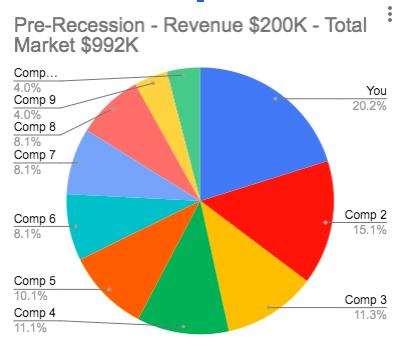 In the first pie chart we look at things as they were pre-COVID-19. After a long period of economic expansion, a lot of competitors entered the fray to cut up the surplus market share. In this overly simple example, there are ten competitors and you own roughly 20% of the demand, which in this example is around 200K. Then, a recession hits.
In the first pie chart we look at things as they were pre-COVID-19. After a long period of economic expansion, a lot of competitors entered the fray to cut up the surplus market share. In this overly simple example, there are ten competitors and you own roughly 20% of the demand, which in this example is around 200K. Then, a recession hits.
2. During a Recession
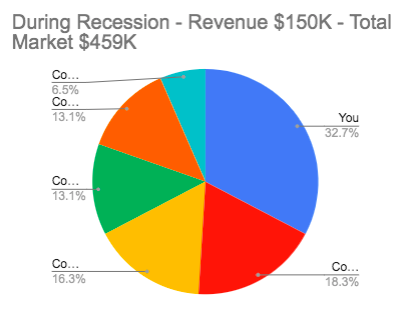 In the second pie chart we see the market contracting in the way we will likely see happen in the coming months. In this example, some of your competitors either temporarily or permanently leave the market. Even though you stay in the market, because of the contracting demand, your revenue goes from $200K to $150K. This is a 25% loss in revenue, and with less revenue to spread across overhead, payroll and other expenses in all likelihood take a hit in profitability.
In the second pie chart we see the market contracting in the way we will likely see happen in the coming months. In this example, some of your competitors either temporarily or permanently leave the market. Even though you stay in the market, because of the contracting demand, your revenue goes from $200K to $150K. This is a 25% loss in revenue, and with less revenue to spread across overhead, payroll and other expenses in all likelihood take a hit in profitability.
Most businesses that survive will need to either spend through savings or go into debt to weather a loss like this. But, not all of this is bad news, because even though in this example you have lost a quarter of your revenue, by staying in the market while your competitors dropped out, you have actually gained 12% of the market share, or to state it differently, a 60% increase from your previous market share.
3. After Recovery
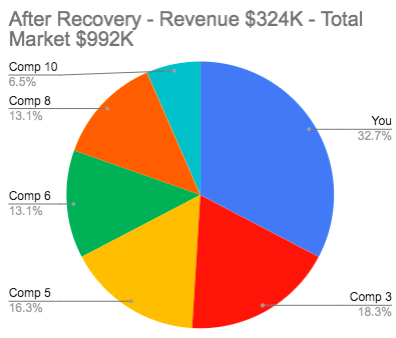 The third pie chart is meant to represent when we finally overcome this disease and the demand re-enters the market, accelerated by government stimulus. In this example I’m fast-forwarding to when the economy recovers. That additional 13% increase in market share translates roughly 62% growth in revenue and equates to an additional 124K for the business topline revenue.
The third pie chart is meant to represent when we finally overcome this disease and the demand re-enters the market, accelerated by government stimulus. In this example I’m fast-forwarding to when the economy recovers. That additional 13% increase in market share translates roughly 62% growth in revenue and equates to an additional 124K for the business topline revenue.
I like what Stephanie said last week in her webinar about PPC budgets during the COVID-19 crisis. Her example is in a lot of ways an example for available market share to be had. She said “PPC ads are ‘on sale’” because the cost-per-click has dropped over the last month as this has all unfolded (More on this later).
This happens precisely because your competitors have ceded market share, and as a result, they have lowered the cost to get new students by not even showing up to the auction.
To echo back to the earlier point about momentum, because of the complexities of AI and machine learning on Google and Facebook ad platforms, you cannot just show up to the auction when demand comes back and hope to win the bids at a low cost.
These platforms are getting really good at pinpointing who is ready to buy and targeting them, but the AI and Machine learning both run on data. If you turn everything off, gathering that data is going to require more time and a lot more money to reach the same result.
8. Remember Demand for Trade Schools Is Counter Recession
This next part is specifically for Oozle’s main client base of trade schools. Specifically, beauty schools are in the midst of a lot of uncertainty. In this niche, over the last two to three years you have been seeing CPC and CPL on your top-performing keywords sharply increase.
This is because as the labor market tightened under low unemployment, there were fewer potential students interested in switching careers. The fight for the shrinking number of potential students pushed prices for their attention higher and higher. I had this conversation so much so that I made this chart to try to explain it to clients that were concerned about rising prices.
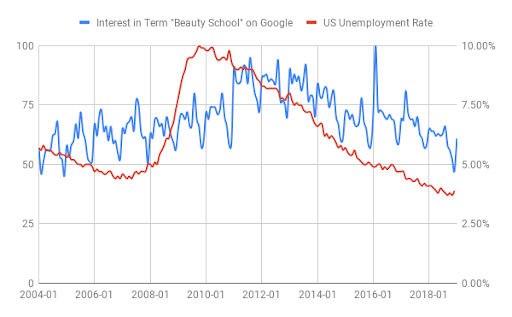
In the chart, you can see the interest in a bellwether term “beauty schools” trends to its highest peak just after unemployment in the US peaks during the last recession and then lowers lock step with the unemployment rate. This makes sense if you think about it, after a few months of high unemployment, people are ready to learn new skills to make them employable.
At the time of me writing this, we are seeing a record number of jobless claims in the United States. While this is not the best news for our economy as a whole, if you are in the trade school business this should at least give you a silver lining on the horizon. As unemployment increases, what should follow is an increased demand from career changers who were recently unemployed looking to be retrained with new skills.
As Oozle has pointed out multiple times in their recent webinars over the last few weeks, if you are able to keep your marketing momentum moving, and the message empathetic and hope-filled during this time of crisis, you have an opportunity to have an outsized effect on those that will eventually become students a few months from now.
In that same webinar they gave some great advice to help capture this demand. Let the market determine your budget for demand-based advertising. Consult often with your paid ads team so they can assess the demand in your market and adjust budgets accordingly.
9. Let Go of Sunk Costs, They Can Only Hurt You
First a definition: “A sunk cost is a cost that has already been incurred and cannot be recovered.” In other words, something you can no longer change.
It is a very frustrating time to own a business. Governments are exercising their full weight to disrupt society, and small and medium sized businesses are collateral damage. I have talked to a lot of business owners who are upset about the measures being taken to control the pandemic, and their effect on the business and the economy as a whole.
This is spilling out into their conversations with clients and sometimes onto their websites or into social media. This has happened so much so that Google has shut down their review platform to help some businesses contain the potential PR nightmare it could cause.
As a business owner and/or marketer, I would advise you to quote a prayer you probably remember from a needlepoint In your grandma’s house. It’s going to sound trite, but I think it’s the right message for the moment.
God grant me the serenity
To accept the things I cannot change;
Courage to change the things I can;
And wisdom to know the difference.
Complaining and/or focusing on the things you can’t change is going to distract you from the things you can have an effect on. Additionally, airing these grievances publically has a really good chance of pissing off some customers or potential students, too.
To be clear here, there is basically no upside to complaining, and there’s a ton of potential downsides.
Don’t do it.
10. Maintain Quality and Make Decisions Based on Core Values
Core values are what we fall back on when there is not a clear best choice. Right now is not a time to pretend you’re something you’re not, but if you have clearly defined values that guide your business, these should be present in your marketing.
At the company I now work for, we preach: Honesty. Integrity. Quality. These are things I can rely on when I write my copy, and it becomes the anchor for our messaging in times of uncertainty. Those three words come up over and over in our copy when we have to explain tough decisions to our customers or employees.
If you are looking for great examples of those who have done this right, re-watch the webinar Oozle and BAAB hosted by Stephanie on Social Media Marketing During COVID-19.
11. Be Kind and Helpful As Much As You Can
I used the oxygen mask example above, here’s the other half of that example. Once you are done placing your own oxygen mask, help others.
There is a very famous Mr. Rogers quote used usually in times of much more sudden striking times of tragedy.
“When I was a boy and I would see scary things in the news, my mother would say to me, ‘Look for the helpers. You will always find people who are helping.’”
I want you to notice something as you wade through the onslaught of bad news. There are only two kinds of companies that are getting noticed in a time like this: those who look greedy and those that are helping.
I know the adage about good publicity and bad publicity. I don’t think it holds in this case. Once this all settles, the companies and the businesses that people are going to want to work with are the ones who were helping, plain and simple. Additionally, helping people gives you an opportunity to get noticed and receive good press. Any good press you recieve now will pay SEO dividends for years.
This also extends to your employees. Treating your employees with respect and dignity (even if you have to eventually lay them off for a time or let them go), will make a big difference in your ability to bring them back and retain employees at the critical moment when you are trying to grow out of this downturn.
12. Remember Good Marketing Is Still Good Marketing
Good marketing always has been, is now, and always will be at its core about effectively telling
- The right story
- To the right audience
- At the right time
I’ll do a more in-depth post about this on this blog at a future date, but for now, what’s important is that this remains true even in a crisis. This is a simple mental check you can do before you communicate a sensitive message. Ask yourself three simple questions:
- Is this the right message for the people that will read or hear this?
- Am I reaching the right audience with the method I am using to get this message out?
- Is this the right time to communicate this in the customer journey, or should it come sooner or later in the journey?
This is why having a partner that knows what good marketing looks like at this time is crucial. If you or your marketing agency doesn’t take the time to get the message right and outreach using the appropriate channels, it could seem greedy, pushy, or offensive. As a result, it could send the exact wrong message for your clients and customers while simultaneously draining your budget.
Bonus: Don’t Do It Alone
I’ll end this post with the same thing I say at the end of every conversation I’ve had recently. Stay safe. If you are having any hesitancy about what to do with your marketing at this time, please talk to a quality marketing agency like Oozle Media. I can attest to the quality of people they have in the organization there, and that they consistently live up to their guiding principle “Do what is in the client’s best interest.”

